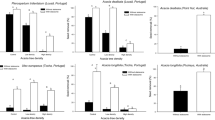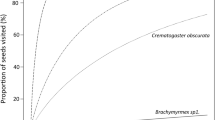Abstract
Seed dispersal by ants (myrmecochory) is a widely distributed plant–animal interaction in many ecosystems, and it has been regarded as a generalized (multiple species) interaction in which specialization on specific ant partners is uncommon. In this paper, we demonstrate species-specific seed dispersal of spotted spurge (Chamaesyce maculata) by ants in Japan. C. maculata produces seeds from summer to autumn in Japan. The seeds produced in autumn are carried by two ant species, Tetramorium tsushimae and Pheidole noda. We performed laboratory experiments to investigate the fate of C. maculata seeds in the nests of T. tsushimae and P. noda. P. noda consumed the seeds in the nest and rarely carried seeds out of the nest, while T. tsushimae consumed only the seed coat, and subsequently carried the seeds out of the nest. Removal of the seed coat by T. tsushimae may increase seed survival by reducing their susceptibility to infection by fungi. We also observed ant responses to filter paper soaked with an aqueous extract of the seed coat. P. noda did not react to the filter paper, but T. tsushimae carried the filter paper into their nest. Analysis by high-pressure liquid chromatography revealed that the aqueous extract contained at least four sugars and one unknown substance. Myrmecochory has been regarded as a generalized interaction with specialization for specific ant partners uncommon. However, our study suggests there is a species-specific interaction in seed dispersal by ants in autumn-flowering individuals of C. maculata in Japan.




Similar content being viewed by others
References
Auld TD (1986) Population dynamics of the shrub Acacia suaveolens (Sm.) Willd.: dispersal and the dynamics of the soil seed-bank. Aust J Ecol 11:235–254
Bascompte J, Jordano P, Melián CJ, Olesen JM (2003) The nested assembly of plant–animal mutualistic networks. Proc Natl Acad Sci USA 100:9383–9387
Beattie AJ (1985) The evolutionary ecology of ant-plant mutualisms. Cambridge University Press, New York
Beattie AJ, Culver DC (1983) The nest chemistry of two seed-dispersing ant species. Oecologia 56:99–103
Bentley BL (1976) Plants bearing extrafloral nectaries and the associated ant community: interhabitat differences in the reduction of herbivore damage. Ecology 57:815–820
Bond WJ, Yeaton R, Stock WD (1991) Myrmecochory in Cape Fynbos. In: Huxley CR, Cutler DF (eds) Ant–plant interactions. Oxford Science, Oxford, pp 448–462
Dawkins R, Krebs JR (1979) Arms races between and within species. Proc R Soc Lond B 205:489–511
Dunn RR, Gove AD, Barraclough TG, Givnish TJ, Majer JD (2007) Convergent evolution of an ant–plant mutualism across plant families, continents, and time. Evol Ecol Res 9:1349–1362
Garrido JL, Rey PJ, Cerdá X, Herrera CM (2002) Geographical variation in diaspore traits of an ant-dispersed plant (Helleborus foetidus): are ant community composition and diaspore traits correlated? J Ecol 90:446–455
Giladi I (2006) Choosing benefits or partners: a review of the evidence for the evolution of myrmecochory. Oikos 112:481–492
Gorb SN, Gorb EV (1995) Removal rates of seeds of five myrmecochorous plants by the ant Formica polyctena (Hymenoptera, Formicidae). Oikos 73:367–374
Guimarães PR Jr, Rico-Gray V, dos Reis SF, Thompson JN (2006) Asymmetries in specialization in ant–plant mutualistic networks. Proc R Soc B 273:2041–2047
Handel SN, Beattie AJ (1990) Seed dispersal by ants. Sci Am 263:58–64
Horvitz CC (1981) Analysis of how ant behaviors affect germination in a tropical myrmecochore Calathea microcephala (P. & E.) Koernicke (Marantaceae): microsite selection and aril removal by neotropical ants, Odontomachus, Pachycondyla, and Solenopsis (Formicidae). Oecologia 51:47–52
Hughes L, Westoby M (1992) Effect of diaspore characteristics on removal of seeds adapted for dispersal by ants. Ecology 73:1300–1312
Janzen DH (1979) How to be a fig. Ann Rev Ecol Syst 10:13–51
Katayama N, Suzuki N (2005) The importance of the encounter rate between ants and herbivores and of ant aggressiveness against herbivores in herbivore exclusion by ants on Vicia angustifolia L. (Leguminosae) with extrafloral nectaries. Appl Entomol Zool 40:69–76
Kato M, Takimura A, Kawakita A (2003) An obligate pollination mutualism and reciprocal diversification in the tree genus Glochidion (Euphorbiaceae). Proc Natl Acad Sci USA 100:5264–5267
Kobayashi Y (2009) The significance of seed dispersal by ants in the prostrate annual, Chamaesyce maculata (L.) Small (Euphorbiaceae) and benefits of carrying the seeds for ants. PhD thesis, Kagoshima University, Kagoshima (in Japanese with English summary)
Koptur S (1992) Extrafloral nectary-mediated interactions between insects and plants. In: Bernays E (ed) Insect–plant interaction, vol IV. CRC, Boca Raton, pp 81–129
Lanza J, Schmitt MA, Awad AB (1992) Comparative chemistry of elaiosomes of three species of Trillium. J Chem Ecol 18:209–221
Lengyel S, Gove AD, Latimer AM, Majer JD, Dunn RR (2010) Convergent evolution of seed dispersal by ants, and phylogeny and biogeography in flowering plants: a global survey. Perspect Plant Ecol Evol Syst 12:43–55
Manzaneda AJ, Rey PJ (2009) Assessing ecological specialization of an ant–seed dispersal mutualism through a wide geographic range. Ecology 90:3009–3022
Mark S, Olesen JM (1996) Importance of elaiosome size to removal of ant-dispersed seeds. Oecologia 107:95–101
Marshall DL, Beattie AJ, Bollenbacher WE (1979) Evidence for diglycerides as attractants in an ant-seed interaction. J Chem Ecol 5:335–344
Nathan R, Muller-Landau HC (2000) Spatial patterns of seed dispersal, their determinants and consequences for recruitment. Trends Ecol Evol 15:278–285
Ohkawara K, Higashi S, Ohara M (1996) Effects of ants, ground beetles and the seed-fall patterns on myrmecochory of Erythronium japonicum Decne (Liliaceae). Oecologia 106:500–506
Ohnishi KY, Suzuki N (2009) Preferential removal of non-injured seeds by an omnivorous ant, Tetramorium tsushimae Emery, in the seed dispersal of Chamaesyce maculata (L.) small. Ecol Res 24:1155–1160
Ohnishi KY, Suzuki N (2011) Seed predator deterrence by seed-carrying ants in a dyszoochorous plant, Chamaesyce maculata L. Small (Euphorbiaceae). Popul Ecol 53:441–447
Ohnishi Y, Suzuki N, Katayama N, Teranishi S (2008) Seasonally different modes of seed dispersal in the prostrate annual, Chamaesyce maculata (L.) Small (Euphorbiaceae), with multiple overlapping generations. Ecol Res 23:299–305
Pellmyr O, Leebens-Mack J (1999) Forty million years of mutualism: evidence for Eocene origin of the yucca–yucca moth association. Proc Natl Acad Sci USA 96:9178–9183
Peters M, Oberrath R, Bohning-Gaese K (2003) Seed dispersal by ants: are seed preferences influenced by foraging strategies or historical constraints? Flora 198:413–420
Pizo MA, Oliveira PS (1998) Interaction between ants and seeds of a nonmyrmecochorous neotropical tree, Cabralea canjerana (Meliaceae), in the Atlantic forest of southeast Brazil. Am J Bot 85:669–674
Pizo MA, Oliveira PS (2001) Size and lipid content of nonmyrmecochorous diaspores: effects on the interaction with litter-foraging ants in the Atlantic rain forest of Brazil. Plant Ecol 157:37–52
Retana J, Picó X, Rodrigo A (2004) Dual role of harvesting ants as seed predators and dispersers of a non-myrmecochorous Mediterranean perennial herb. Oikos 105:377–385
Suzuki N, Ohnishi Y (2006) Significance of the simultaneous growth of vegetative and reproductive organs in the prostrate annual Chamaesyce maculata (L.) Small (Euphorbiaceae). Ecol Res 21:91–99
Suzuki N, Teranishi S (2005) Phenology and life cycle of the annual, Chamaesyce maculata (L.) Small (Euphorbiaceae), with multiple overlapping generations in Japan. Ecol Res 20:425–432
Thompson JN (2005) The geographic mosaic of coevolution. University Chicago Press, Chicago
Westoby M, French K, Hughes L, Rice B, Rodgerson L (1991) Why do more plant species use ants for dispersal on infertile compared with fertile soils. Aust J Ecol 16:445–455
Whitney KD (2002) Dispersal for distance? Acacia ligulata seeds and meat ants Iridomyrmex viridiaeneus. Austral Ecol 27:589–595
Wilson MF (1993) Dispersal mode, seed shadows, and colonization patterns. Vegetatio 107(108):261–280
Youngsteadt E, Baca JA, Osborne J, Schal C (2009) Species-specific seed dispersal in an obligate ant-plant mutualism. PLoS One 4:1–11
Zelikova TJ, Dunn RR, Sanders NJ (2008) Variation in seed dispersal along an elevational gradient in Great Smoky Mountains National Park. Acta Oecologica 34:155–162
Acknowledgments
We are grateful for the assistance provided by the members of the Laboratory of System Ecology, Saga University and Center for Ecological Research, Kyoto University. We thank S. Teranishi, M. Ushio and K. Hashimoto for comments on this paper. We also thank D. Hembry and M. Whitaker for correcting the English of the text. This study was partly supported by the Global COE program A06 of Kyoto University, and by Grants-in-Aid from the Ministry of Education, Science, Sports and Culture of Japan (Grant nos. 14540582 and 19570022).
Author information
Authors and Affiliations
Corresponding author
Additional information
Yoshihiro K. Ohnishi and Nobuhiko Suzuki—The late doctors.
Electronic supplementary material
Below is the link to the electronic supplementary material.
Rights and permissions
About this article
Cite this article
Ohnishi, Y.K., Katayama, N. & Suzuki, N. Differential dispersal of Chamaesyce maculata seeds by two ant species in Japan. Plant Ecol 214, 907–915 (2013). https://doi.org/10.1007/s11258-013-0217-7
Received:
Accepted:
Published:
Issue Date:
DOI: https://doi.org/10.1007/s11258-013-0217-7




